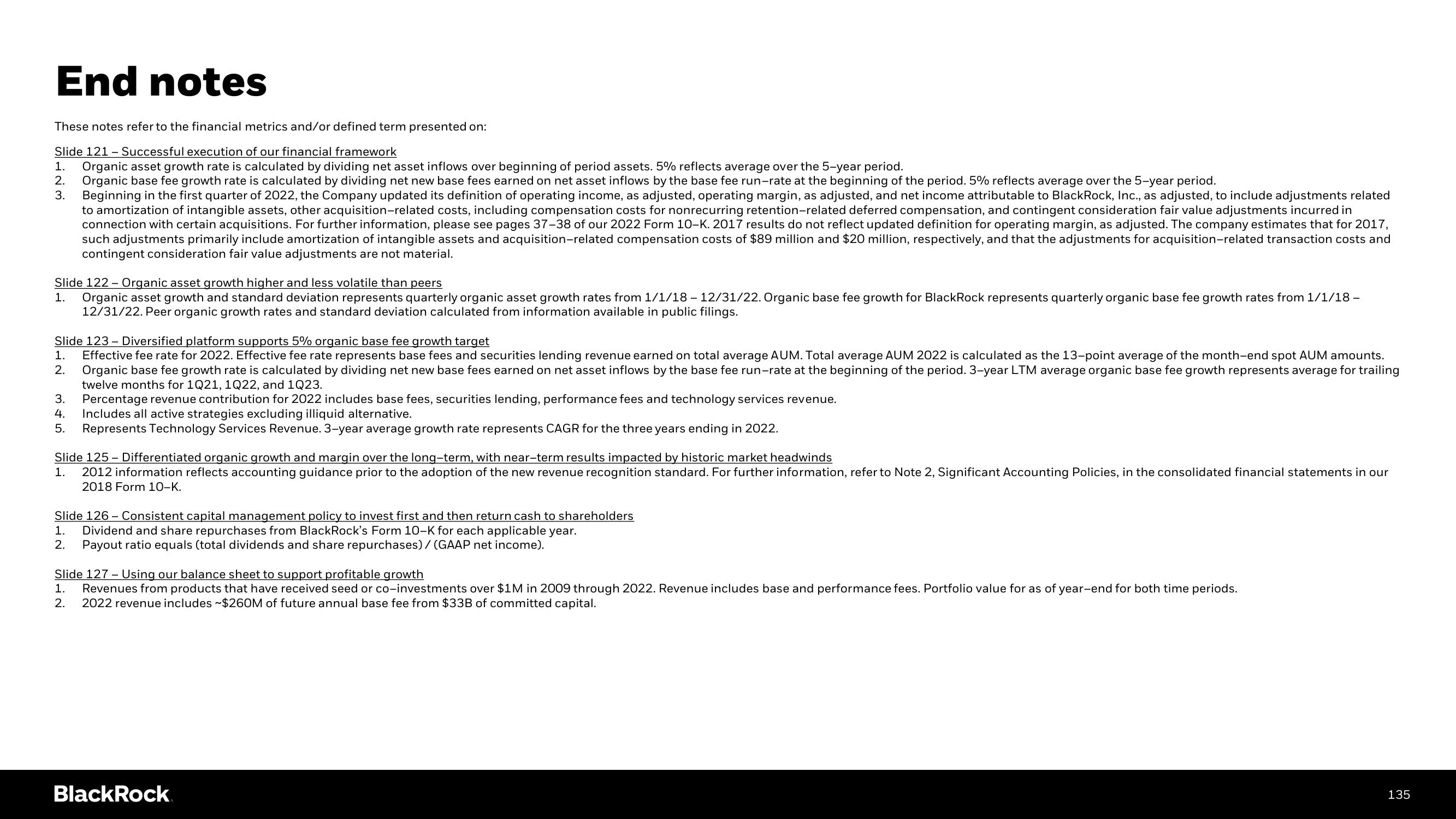BlackRock Investor Day Presentation Deck
End notes
These notes refer to the financial metrics and/or defined term presented on:
Slide 121 Successful execution of our financial framework
1. Organic asset growth rate is calculated by dividing net asset inflows over beginning of period assets. 5% reflects average over the 5-year period.
2. Organic base fee growth rate is calculated by dividing net new base fees earned on net asset inflows by the base fee run-rate at the beginning of the period. 5% reflects average over the 5-year period.
3. Beginning in the first quarter of 2022, the Company updated its definition of operating income, as adjusted, operating margin, as adjusted, and net income attributable to BlackRock, Inc., as adjusted, to include adjustments related
to amortization of intangible assets, other acquisition-related costs, including compensation costs for nonrecurring retention-related deferred compensation, and contingent consideration fair value adjustments incurred in
connection with certain acquisitions. For further information, please see pages 37-38 of our 2022 Form 10-K. 2017 results do not reflect updated definition for operating margin, as adjusted. The company estimates that for 2017,
such adjustments primarily include amortization of intangible assets and acquisition-related compensation costs of $89 million and $20 million, respectively, and that the adjustments for acquisition-related transaction costs and
contingent consideration fair value adjustments are not material.
Slide 122 Organic asset growth higher and less volatile than peers
1. Organic asset growth and standard deviation represents quarterly organic asset growth rates from 1/1/18 - 12/31/22. Organic base fee growth for BlackRock represents quarterly organic base fee growth rates from 1/1/18 -
12/31/22. Peer organic growth rates and standard deviation calculated from information available in public filings.
Slide 123 - Diversified platform supports 5% organic base fee growth target
Effective fee rate for 2022. Effective fee rate represents base fees and securities lending revenue earned on total average AUM. Total average AUM 2022 is calculated as the 13-point average of the month-end spot AUM amounts.
Organic base fee growth rate is calculated by dividing net new base fees earned on net asset inflows by the base fee run-rate at the beginning of the period. 3-year LTM average organic base fee growth represents average for trailing
twelve months for 1Q21, 1Q22, and 1Q23.
3. Percentage revenue contribution for 2022 includes base fees, securities lending, performance fees and technology services revenue.
Includes all active strategies excluding illiquid alternative.
5. Represents Technology Services Revenue. 3-year average growth rate represents CAGR for the three years ending in 2022.
1.
N
2.
345
4.
Slide 125 Differentiated organic growth and margin over the long-term, with near-term results impacted by historic market headwinds
1. 2012 information reflects accounting guidance prior to the adoption of the new revenue recognition standard. For further information, refer to Note 2, Significant Accounting Policies, in the consolidated financial statements in our
2018 Form 10-K.
Slide 126 Consistent capital management policy to invest first and then return cash to shareholders
1. Dividend and share repurchases from BlackRock's Form 10-K for each applicable year.
2. Payout ratio equals (total dividends and share repurchases) / (GAAP net income).
Slide 127 Using our balance sheet to support profitable growth
1.
Revenues from products that have received seed or co-investments over $1M in 2009 through 2022. Revenue includes base and performance fees. Portfolio value for as of year-end for both time periods.
2022 revenue includes ~$260M of future annual base fee from $33B of committed capital.
2.
BlackRock
135View entire presentation